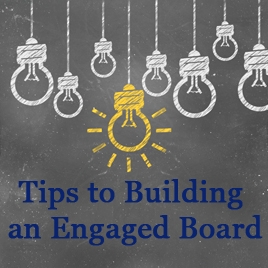 By Peter Fissinger, President & CEO of Campbell & Company
By Peter Fissinger, President & CEO of Campbell & Company
An organization’s board is a key ingredient to increasing a nonprofit’s impact in its community – and having the right people on the board is critical to the success of the organization.
During Campbell & Company’s 38 years, we have debated whether nonprofit boards should have term limits. And in the larger nonprofit community, this is a widely debated topic. Essentially, I favor term limits. I believe that by having term limits, an organization is forced to have to continually work on building and developing its board, and as a result this leads to stronger board development and engagement practices. Among the many benefits of having term limits include: fresh energy and perspectives from new board members, avoiding “board member burnout”, and expansion of constituency and expertise.
Here are a few board development tips that will impact the engagement level of your governing board:
- Make the board development committee central to the working of the board. This group, which should include the board chair, the CEO and the chief development officer – among others – should be charged with developing and sustaining a great board.
 Develop clear criteria, including providing expectations, for all prospective board members. Knowing what kind of trustee you are looking for will impact your ability to identify strong candidates.
Develop clear criteria, including providing expectations, for all prospective board members. Knowing what kind of trustee you are looking for will impact your ability to identify strong candidates.
- Establish a strong list of potential trustees. Many boards become weaker when there are no good candidates and there are vacancies to be filled. It is important for your board to develop a list of potential members who fit the culture and vision of the organization.
- Meet with prospective board members, in person, at least once before inviting them to consider serving as a trustee. Make sure you review the benefits (impact on mission) and responsibilities all trustees have before asking a candidate to serve.
- Create a strong orientation program. In order for board members to succeed, they need to understand the organization. And having an effective orientation programs get them off to a good start. Examples can include special tours, meeting organization staff and leadership, attending events.
- Assign new board members to at least one committee. Serving on a committee will engage new trustees at a ground level, allowing them to meet people and make a difference. Learn about your board members’ interests and talents, and try to assign them appropriately.
- Evaluate trustee involvement (and effectiveness) annually. Many board develop a scorecard to measure the performance of board members on key indicators: meeting attendance, committee participation, financial support. This can be a guide to use when evaluating trustees. Remember a scorecard does not tell the whole story.
- Meet with board members annually to receive their feedback on the quality of their engagement. This is easier said than done, but can go a long way toward either keeping trustees engaged or beginning the process of considering whether a particular trustee might consider resigning his or her position to someone who is better suited to the job.
It is true, a board can do all these things whether the organization has term limits or not. But the recruitment cycle term limits impose tend to focus boards more toward board development, and good board development is a critical key to creating and sustaining an engaged board.